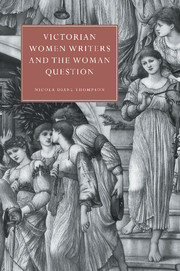Book contents
- Frontmatter
- Contents
- List of illustrations
- Notes on contributors
- 1 Responding to the woman questions: rereading noncanonical Victorian women novelists
- 2 Marriage and the antifeminist woman novelist
- 3 Breaking apart: the early Victorian divorce novel
- 4 Phantasies of matriarchy in Victorian children's literature
- 5 Gendered observations: Harriet Martineau and the woman question
- 6 Maximizing Oliphant: begging the question and the politics of satire
- 7 Literary women of the 1850s and Charlotte Mary Yonge's
- 8 Portraits of the artist as a young woman: representations of the female artist in the New Woman fiction of the 1890s
- 9 Lady in green with novel: the gendered economics of the visual arts and mid-Victorian women's writing
- 10 Ouida and the other New Woman
- 11 Organizing women: New Woman writers, New Woman readers, and suffrage feminism
- 12 Shot out of the canon: Mary Ward and the claims of conflicting feminism
- 13 E. Nesbit and the woman question
- 14 “An ‘old-fashioned’ young woman”: Marie Corelli and the New Woman
- CAMBRIDGE STUDIES IN NINETEENTH-CENTURY LITERATURE AND CULTURE
10 - Ouida and the other New Woman
Published online by Cambridge University Press: 01 March 2010
- Frontmatter
- Contents
- List of illustrations
- Notes on contributors
- 1 Responding to the woman questions: rereading noncanonical Victorian women novelists
- 2 Marriage and the antifeminist woman novelist
- 3 Breaking apart: the early Victorian divorce novel
- 4 Phantasies of matriarchy in Victorian children's literature
- 5 Gendered observations: Harriet Martineau and the woman question
- 6 Maximizing Oliphant: begging the question and the politics of satire
- 7 Literary women of the 1850s and Charlotte Mary Yonge's
- 8 Portraits of the artist as a young woman: representations of the female artist in the New Woman fiction of the 1890s
- 9 Lady in green with novel: the gendered economics of the visual arts and mid-Victorian women's writing
- 10 Ouida and the other New Woman
- 11 Organizing women: New Woman writers, New Woman readers, and suffrage feminism
- 12 Shot out of the canon: Mary Ward and the claims of conflicting feminism
- 13 E. Nesbit and the woman question
- 14 “An ‘old-fashioned’ young woman”: Marie Corelli and the New Woman
- CAMBRIDGE STUDIES IN NINETEENTH-CENTURY LITERATURE AND CULTURE
Summary
[T]here are conspicuous at the present two words which designate unmitigated bores: The Workingman and the New Woman
OuidaOuida's antifeminism was vocal; her denunciation of the New Woman did as much to lend currency to the term as feminist apologists did. That antifeminism, combined with stylistic extravagance, has contributed to render Ouida invisible within today's canon, in which she can be classified neither as canonical nor as a feminist foremother. Yet, Ouida's fiction is not simply opposed to the interests of New Women novelists. Certainly, for example, Ouida is a believer in aristocratic privilege; her reasons, however, are embedded in notions of eugenics which inform much New Woman writing. Her hatred of socialism is curiously mixed – though a resolute defender of private property, her main critique of the redistribution of power appears in the Italian novels as a critique of abuses which are liable to occur in the opportunism attending social transition, particularly sexual abuse of women. Her partisanship of animal rights is specifically connected to women's abuse under patriarchy as it often is in New Woman fiction. Ouida is wholly opposed to Female Suffrage and the New Woman, but in part for reasons which are aligned with the reasoning of New Women like George Egerton and Victoria Cross, who see in women's sexuality a power distinct from the power of men. In short, Ouida's conservatism is formulated through a radical rhetoric.
Many of Ouida's characters anticipate the New Woman. Most importantly for our purposes here, her portrayal of women often licenses extramarital sexuality as an expression of a higher ethical standard in a world wherein marriage is corrupted by the profit motive.
- Type
- Chapter
- Information
- Victorian Women Writers and the Woman Question , pp. 170 - 188Publisher: Cambridge University PressPrint publication year: 1999
- 4
- Cited by

